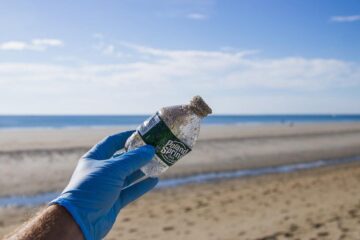Pemmican is a traditional food that, for centuries, played an important role in the diet of various Native American tribes. In time it was discovered and adopted by Western explorers, trappers, scouts and others who roamed the vast North American wilderness during frontier days.
The word is derived from the Cree (1) word pimîhkân, which denotes “grease” or “animal fat”. Below we’re going to take a close look at pemmican and provide a recipe for making this early type of emergency ration the way Lewis and Clarke might have.
What Made Pemmican So Popular?
Pemmican is often confused with beef jerky but it’s not the same thing. Beef jerky consists almost entirely of dried beef, with salt, sugar and some seasonings thrown in for taste. By comparison, pemmican is comprised of dried meat and tallow (2), which is a form of rendered beef fat.
That may not sound like much of a difference, but that tallow played an important role in making pemmican an in-demand food staple for frontier types.
Tallow is rich in monounsaturated fat (3) that helps your body absorb vitamins A, D, E and K, which, in turn, support your immune system, heart, bones and more. Tallow also contains fatty acids that promote healthy metabolism and help your body burn off its own fat for energy. Oh, and it’s good for your skin too.
What made pemmican so appealing to trappers and explorers – who often went months without a good home-cooked meal – was its portability and the fact that it’s non-perishable. Depending on the recipe used, pemmican can last anywhere from 1 to 5 years. Which means if you have a decent amount of it in your backpack you’ve got something to eat no matter where you are.
Because pemmican is nutrient dense, provides the above-listed benefits, and is naturally low in carbs it has come very much back into vogue as a type of all-purpose food for those on the paleo (4) and keto (5) diets.
A Brief History of Pemmican
No one knows the precise origins of pemmican, but by the time explorers and fur traders first ventured into the vast heart of North America it was already a dietary staple of the Native American and First Nations people those traders and explorers encountered.
While we tend to make it today from beef, native peoples of the 16th century used bison (6) or other types of wild game to make their pemmican. They would then bring it with them on hunts, or in some cases, stash it at various places throughout their traditional hunting lands so they would always have something to eat during their long, arduous journeys.
During the 16th and 17th century French, and then British fur traders recognized the immense practical value of pemmican and quickly adopted its use. Without it, the history of North America from a colonial perspective would be quite different.
Trappers, traders and explorers wandering the plains, especially during the winter, were in no small part able to survive because of their adoption of pemmican. Lewis and Clark, during their exploration of the newly acquired Louisiana Territory in the early 19th century noted that the Mandan Tribe (7)(8) provided their expedition with a large amount of Pemmican which was used to help the party complete their historic journey to the Pacific Coast.
Other famous explorers and expeditions that relied heavily on pemmican include:
- Fridtjof Nansen’s first crossing of the interior of Greenland in 1888 (9).
- The infamous 1914 Antarctic expedition of Ernest Shackelton (10) relied heavily on dog pemmican made from his sled dogs after the expedition became stranded in pack ice.
- Robert Peary used pemmican on his journey to the North Pole. According to Peary, “Too much cannot be said of the importance of pemmican to a polar expedition.”
- During the Second Boer War (11) at the turn of the 20th century British soldiers were given pemmican as part of their standard rations.
- As recently as World War II US airmen were issued emergency rations that included pemmican.
- And as we mentioned earlier, pemmican is making a comeback these days as a popular choice for keto and paleo dieters.
The Return of Pemmican
Recent events have shined a glaring light on the subject of preparedness, with millions of people now seeking to emulate the preppers they once mocked (12). As a result, there has been a renewed interest in traditional survival foods like pemmican that can be cooked today and then stashed away, perhaps for a few years, to be accessed should the SHTF.
So let’s look at how to create your own pemmican using a more-or-less traditional recipe. “More or less” because we won’t be slaughtering any animals or going out and picking wild berries to make it, the way 16th century fur trappers did, but instead using store-bought ingredients.
Traditional Pemmican Recipe
First thing you will need are the ingredients. Like we mentioned we won’t be slaughtering any cattle for the purposes of this recipe. Instead, we’ll rely on store bought meat . With that in mind here are the ingredients.
Ingredients
- Lean meat. In this case commercially available beef (But if you have fresh elk, deer, moose, or bison please feel free to use that instead).
- Dried cranberries, blueberries or juneberries. Note that berries are optional and were only used by trappers etc when they were available. Also, any fruit must be dried fruit.
- Tallow. As we mentioned at the outset, tallow is rendered beef fat. These days you don’t have to slaughter a cow yourself to obtain it. You can buy it through Amazon or a hundred other online outlets.
- Spices (optional). Like fruit, Native Americans and fur trappers used whatever spices were available at the time. Sometimes that meant no spices. If you like you can use allspice or sugar.
You’ll notice we haven’t mentioned amounts because 16th century trappers didn’t bring measuring cups with them into the wild. The most important thing is to have roughly equal amounts of beef and tallow and then enough other ingredients to make the finished product palatable.
Instructions
Dry the meat – The first thing to do is prepare the beef (or whatever meat you’re using). That means cutting it into thin strips. Once you’ve done that you need to dry the meat out. Our ancestors would lay the meat out in the sun all day on rocks or rope lines. You can do that if you wish. But we’re going to use the oven instead. So put the strips on a rack and place them in the oven at 170° F for 6 hours. You can also choose to use a freeze drying machine. The goal is to bake off as much moisture as possible. Note: to make it easier to cut the meat into very thin strips, place it in the freezer for 20 minutes or so before slicing.
Shred the meat – Once the meat is thoroughly dry you’ll need to shred it. Again, this is something the Plains Indians and fur trappers would do using a blade, and you can certainly do that if you wish (just be careful). We’re going to place the strips into a food processor instead. Check the product periodically and note its texture. When it’s completely free of chunks and has a fluffy, flossy quality, it’s ready to use.
Mix in the berries and seasonings – At this point you will mix any dried fruit and spices to the mix. That includes sugar if you feel so inclined. Just remember sugar will compromise the authentic quality.
Add the tallow – At this point you will add the tallow you bought at the local market or online. The purpose of the tallow is two-fold. First, it adds nutritional value and second, it provides the mixture with cohesiveness that allows you to form it into whatever shape appeals to you. Fur trappers in the wild would have just pressed it into balls. You can do that, or you can spread it out on a cookie sheet and then cut it into squares.
Once you’ve mixed everything together and formed it into the shapes you want, let it sit for about an hour to coalesce.
Storing Your Pemmican
The great thing about pemmican, the thing that made it so appealing to Plains Indians, explorers and trappers, was that it wasn’t delicate. You could just shove it into your pocket and it would remain viable indefinitely as long as the weather was cool.
We don’t advocate carrying it around loose in your pocket, but if that floats your boat, more power to you. Just remember, the important thing is to not let it get too hot, lest the tallow should start to go bad. If you’re going to store it away for potential use during future emergencies, just put it in the fridge. Either that or put it in some tupperware and store it in a cool, dry place, like the basement. This can be a stable for preppers.
The Bottom Line
Pemmican is a hearty, no-nonsense food from a heartier, no-nonsense time when people were tougher than they are today. It has the unvarnished appeal of frontier food but it’s not just a nostalgia trip for people on trendy diets. It’s viable survival food that can come in extremely handy when the SHTF, the power is out, order has broken down and you’re forced onto the road with no clear safe place to go.


